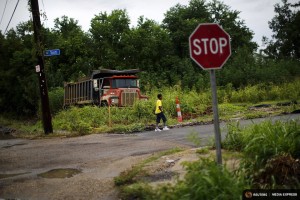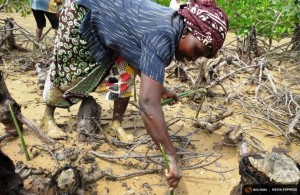
Ballet in Brazil’s ‘Crackland’. By Nacho Doce (*unlocked)
On the outskirts of Sao Paulo in Brazil, the rough Luz neighbourhood – known as Cracolandia or “Crackland” locally for its widespread use of crack cocaine – might seem a world away from the beauty and grace usually associated with ballet. But there’s another side to life in Luz, in a country that’s among the world’s biggest consumers of crack cocaine.

Hurricane Katrina 10 years on, a Photo-Essay by Carlos Barria (*unlocked)
When I arrived in New Orleans after the 2005 hurricane, which caused flooding in 80 percent of the city and killed 1,572 people, the scene was quietly apocalyptic. There was dark water all around, empty highways, bodies wrapped in plastic. The calm before the storm, the saying goes. But for many survivors of Katrina, it’s the calm after the storm that truly haunts.
Europe faces a 1945 moment, by Jonathan Manthorpe, International Affairs columnist (*subscription)
Astonishingly, Europe’s dysfunctional and divisive refugee policies have now collapsed entirely in the face of the onslaught of hundreds of thousands of asylum seekers from the Middle East and Africa. The last time Europe faced a similar crisis on this scale was at the end of the Second World War, which carries many experiences and lessons, some of which are worth examining in the light of what is happening today.

Kenyan fishers swap boats for mangroves and mariculture. By Sophie Mbugua (*unlocked)
Coastal mangrove forests, which are being destroyed quickly, are among the world’s most important wetland ecosystems, providing crucial habitat for wildlife and fish, slowing coral reef sedimentation, and protecting coastlines from severe weather events. One solution has been found by a Kenyan community group, which acts as a volunteer forest guard, restores Kenyan mangroves, and maintains tidal fish ponds — both helping to conserve local marine life, and make a living for its members as climate change impacts bite and fish catches on the open sea shrink.
Bucking Pop Music Labels: Colleen Peterson, Brief Encounters by Brian Brennan (*subscription)
The newspapers couldn’t figure out how to classify Colleen Peterson’s singing when she was first making her way in the music business in the late 1960s. Neither could the record industry. Sometimes she was listed under folk, other times she was classified as blues, other times she was categorized as country. When asked to provide her own description, Peterson offered a new coinage: CRB, country rhythm and blues.
Apocalypse now: our obsession with the end of the world. By Natasha O’Hear and Anthony O’Hear (*unlocked)
What constitutes an “apocalypse” has mutated dramatically over the centuries, from the English to the Jewish to Barack Obama. And the torrid apocalyptic speculation surrounding our own era is nothing out of the ordinary. In constantly citing it today, journalists are drawing on a distinguished and rich apocalyptic tradition, the details of which may have been updated to reflect new global developments and social trends.
Maybe this time America won’t run away from better gun laws, by Tom Regan, Seeking Orenda column (*unlocked)

Perhaps I’m being overly optimistic (heaven knows I thought this would come before now), but I think we might be at a crucial tipping point moment in the long history of trying to enact stronger gun regulations in the United States, and finally putting the demon of the National Rifle Association behind us.
Sam McClure, Muckraker, by Jim McNiven, Thoughtlines column (*subscription)
There were reasons why Sam McClure’s low-cost, good quality magazine sold well in the tough economic climate from 1890:: cheaper postal rates and rural delivery; new technology including high-speed presses and halftone photoengraving; and a growing demand for low-cost outlets for advertising. McClure’s also innovated with an in-house staff of writers and editors.
Fighting Olympic eviction in Rio favela, by Ricardo Moraes, Reuters (*unlocked)
As sports arenas rise up around them and the houses of neighbours are reduced to rubble, more than 20 families refuse to leave their favela, or squatter settlement, on the border of the Olympic Park in Rio de Janeiro, vowing to fight eviction whatever the cost. With just a year to go before the Games come to Brazil, over 90 percent of residents in the slum of Vila Autodromo have already left after accepting compensation and their homes destroyed. Some 50 or so families remain, living in a ghost town with sporadic access to water and electricity and having suffered violent run-ins with police. About half of those families are digging in their heels.

In Case You Missed It:
Focus on the Pacific War:
- Japanese Remorse: Once More With Feeling, column
- JONATHAN MANTHORPE (*subscription)
- European Scientists, Yankee Managers, and ‘The Bomb’
- JIM MCNIVEN (*subscription)
- Shadows of Hiroshima and Nagasaki, a photo essay
- ISSEI KATO
- Why do we pay so much attention to Hiroshima and Nagasaki?
- MATTHEW SELIGMANN
- Hiroshima’s literary legacy
- DANIEL CORDLE
Military gambit behind Putin’s Arctic oil ambitions.
JAMES HENDERSON
Science seeks solutions for drug-tainted waterways
ELIZABETH GROSSMAN
Old Traditions, New Pastures: Portugal’s last shepherds
RAFAEL MARCHANTE, Reuters
HBO’s “Show Me a Hero:” Q&A With David Simon
MARCELO ROCHABRUN
UPDATED August 29 to correct a columnist’s byline
~~~
*Facts and Opinions is a boutique journal, of reporting and analysis in words and images, without borders. Independent, non-partisan and employee-owned, F&O is funded by you, our readers. We do not carry advertising or “branded content,” or solicit donations from foundations or causes; this is possible because some of our work is behind a paywall. Please support us by purchasing a $1 day pass or subscription (click here), making a donation, and/or spreading the word.

